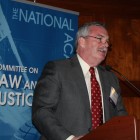
OP-ED: Who Benefits from Zero Tolerance Policies?
|
I have been out of high school since 1984, and I realize that things these days are different. It was a time when kids were told to punch bullies in the nose (or the solar plexus), when I usually had a knife in my pocket (because that’s what guys did), there were no police at the school, and breaking a rule could get you suspended or expelled, but not handcuffed, and certainly not put in jail. It was the time before Columbine, and the slew of other school shootings that have led us down the path of zero tolerance, anti-bullying, police officers in schools and the related criminalization of actions that would have previously been solved through school discipline. It was a time before wearing a t-shirt could get a kid threatened with fines and jail time, no matter what the shirt said. That is exactly what has happened to Jared Martin, a 14-year-old student at Logan Middle School in Logan City, W.Va.





